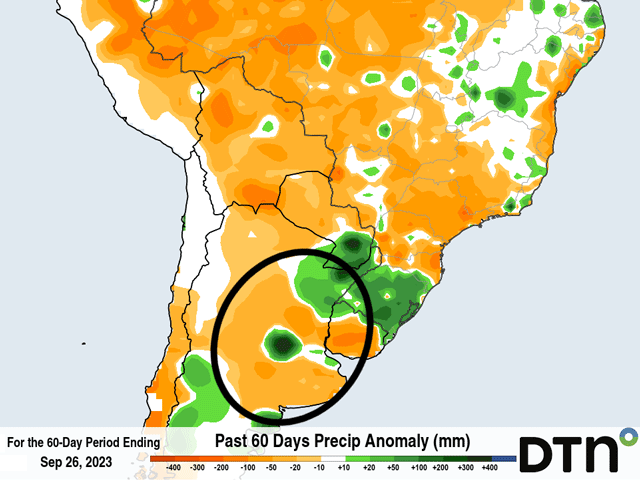Ag Weather Forum
Argentina Needs More Rain
The 2022-23 growing season in Argentina was a complete disaster. Heat and a historic drought, thanks to the third-straight season under La Nina conditions in the Pacific Ocean, wiped away roughly half of the expected production of both corn and soybeans.
Initial estimates from USDA were 55 million metric tons (mmt) of corn and 51 mmt of soybeans for Argentina. In the end, estimates were only that 34 mmt (minus 39%) of corn and 25 mmt (minus 51%) of soybeans were actually produced.
This year, USDA and others are anticipating that El Nino's influence of largely favorable weather conditions for the season are expected to bring a bounceback in production of 54 mmt of corn and 48 mmt of soybeans in the latest World Agricultural Supply and Demand Estimates (WASDE) report.
Coming off of that historic drought puts added pressure on early season development of crops. Rainfall during the last couple of months has not been able to bring soil moisture up to good levels just yet. Plenty of systems have moved through, but the precipitation they brought has been light until getting into far northeastern areas of the country, Paraguay, and especially southern Brazil.
P[L1] D[0x0] M[300x250] OOP[F] ADUNIT[] T[]
Only a limited section of the primary Pampas (meaning "Prairies" in Spanish) growing region, around southeastern Cordoba, southern Santa Fe, and northwest Buenos Aires saw decent rainfall, where satellite estimates of soil moisture are rated as adequate. Otherwise, the Pampas are largely dry.
Planting conditions are therefore mixed as it is great to get equipment out into the field, but hard for seeds to germinate uniformly with worries of too little soil moisture for the vulnerable crop to survive.
Wheat production is also taking a hit due to the dryness. Now in its filling stage, wheat needs more rain to feel good about decent production in the region.
El Nino should continue to provide plenty of opportunities for weather systems to move through the region. One such system is expected to move through Argentina Oct. 3-4. Another may be possible the following weekend.
Rainfall amounts, however, are limited. The most recent European ECMWF model currently has scattered amounts of less than 20 millimeters (about 0.80 inches) with the first system, and the second is largely beyond its forecast window. The American GFS model is even more scant with the precipitation, with both systems averaging less than 15 millimeters (about 0.60 inches) in most areas.
Without adequate rainfall soon, producers there may push back their corn plantings, which puts more of it in a window with lower total sunlight for producing good yields. Wheat yields may also decrease.
To find more international weather conditions and your local forecast from DTN, visit https://www.dtnpf.com/….
John Baranick can be reached at john.baranick@dtn.com
(c) Copyright 2023 DTN, LLC. All rights reserved.





Comments
To comment, please Log In or Join our Community .